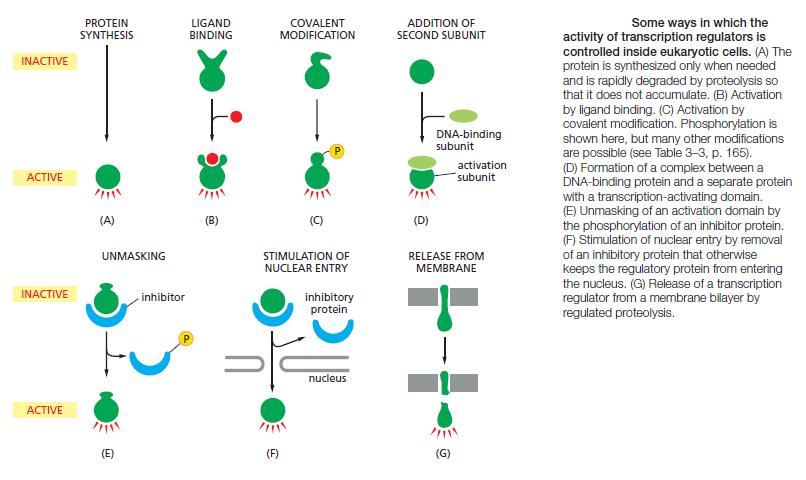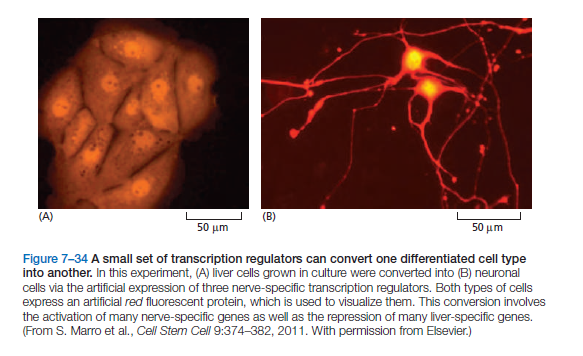MOLECULAR GENETIC MECHANISMS THAT CREATE AND MAINTAIN SPECIALIZED CELL TYPES
Although all cells must be able to switch genes on and off in response to changes in their environments, the cells of multicellular organisms have this capacity to an extreme degree. In particular, once a cell in a multicellular organism becomes committed to differentiate into a specific cell type, the cell maintains this choice through many subsequent cell generations, which means that it remembers the changes in gene expression involved in the choice. This phenomenon of cell memory is a prerequisite for the creation of organized tissues and for the maintenance of stably differentiated cell types. In contrast, other changes in gene expression in eukaryotes, as well as most such changes in bacteria, are only transient. The tryptophan repressor, for example, switches off the tryptophan genes in bacteria only in the presence of tryptophan; as soon as tryptophan is removed from the medium, the genes are switched back on, and the descendants of the cell will have no memory that their ancestors had been exposed to tryptophan. Following, we shall examine not only cell memory mechanisms, but also how gene regulatory devices can be combined to create the “logic circuits” through which cells integrate signals and remember events in their past. We begin by considering one such complex gene control region in detail.
Transcription Regulators Are Brought Into Play by Extracellular Signals
In embryos of most organisms and in all adults, individual nuclei are in separate cells, and extracellular information (including positional cues) must be passed across the plasma membrane so as to generate signals in the cytosol that cause different transcription regulators to become active in different cell types. Some of the different mechanisms that are known to be used to activate transcription regulators are diagrammed in Figure below:

Combinatorial Gene Control Creates Many Different Cell Types
Transcription regulators can act in combination to control the expression of an individual gene. It is also generally true that each transcription regulator in an organism contributes to the control of many genes. Combinatorial gene control makes it possible to generate a great deal of biological complexity even with relatively few transcription regulators.

Due to combinatorial control, a given transcription regulator does not necessarily have a single, simply definable function as commander of a particular battery of genes or specifier of a particular cell type. Rather, transcription regulators can be likened to the words of a language: they are used with different meanings in a variety of contexts and rarely alone; it is the well-chosen combination that conveys the information that specifies a gene regulatory event. Combinatorial gene control causes the effect of adding a new transcription regulator to a cell to depend on that cell’s past history, since it is this history that determines which transcription regulators are already present. Thus, during development, a cell can accumulate a series of transcription regulators that need not initially alter gene expression. The addition of the final members of the requisite combination of transcription regulators will complete the regulatory message, and can lead to large changes in gene expression. The importance of combinations of transcription regulators for the specification of cell types is most easily demonstrated by their ability—when expressed artificially—to convert one type of cell to another. Thus, the artificial expression of three neuron-specific transcription regulators in liver cells can convert the liver cells into functional nerve cells

In some cases, expression of even a single transcription regulator is sufficient to convert one cell type to another. For example, when the gene encoding the transcription regulator MyoD is artificially introduced into fibroblasts cultured from skin connective tissue, the fibroblasts form muscle-like cells. Fibroblasts, which are derived from the same broad class of embryonic cells as muscle cells, have already accumulated many of the other necessary transcription regulators required for the combinatorial control of the muscle-specific genes, and the addition of MyoD completes the unique combination required to direct the cells to become muscle.
Although all cells must be able to switch genes on and off in response to changes in their environments, the cells of multicellular organisms have this capacity to an extreme degree. In particular, once a cell in a multicellular organism becomes committed to differentiate into a specific cell type, the cell maintains this choice through many subsequent cell generations, which means that it remembers the changes in gene expression involved in the choice. This phenomenon of cell memory is a prerequisite for the creation of organized tissues and for the maintenance of stably differentiated cell types. In contrast, other changes in gene expression in eukaryotes, as well as most such changes in bacteria, are only transient. The tryptophan repressor, for example, switches off the tryptophan genes in bacteria only in the presence of tryptophan; as soon as tryptophan is removed from the medium, the genes are switched back on, and the descendants of the cell will have no memory that their ancestors had been exposed to tryptophan. Following, we shall examine not only cell memory mechanisms, but also how gene regulatory devices can be combined to create the “logic circuits” through which cells integrate signals and remember events in their past. We begin by considering one such complex gene control region in detail.
Transcription Regulators Are Brought Into Play by Extracellular Signals
In embryos of most organisms and in all adults, individual nuclei are in separate cells, and extracellular information (including positional cues) must be passed across the plasma membrane so as to generate signals in the cytosol that cause different transcription regulators to become active in different cell types. Some of the different mechanisms that are known to be used to activate transcription regulators are diagrammed in Figure below:

Combinatorial Gene Control Creates Many Different Cell Types
Transcription regulators can act in combination to control the expression of an individual gene. It is also generally true that each transcription regulator in an organism contributes to the control of many genes. Combinatorial gene control makes it possible to generate a great deal of biological complexity even with relatively few transcription regulators.

Due to combinatorial control, a given transcription regulator does not necessarily have a single, simply definable function as commander of a particular battery of genes or specifier of a particular cell type. Rather, transcription regulators can be likened to the words of a language: they are used with different meanings in a variety of contexts and rarely alone; it is the well-chosen combination that conveys the information that specifies a gene regulatory event. Combinatorial gene control causes the effect of adding a new transcription regulator to a cell to depend on that cell’s past history, since it is this history that determines which transcription regulators are already present. Thus, during development, a cell can accumulate a series of transcription regulators that need not initially alter gene expression. The addition of the final members of the requisite combination of transcription regulators will complete the regulatory message, and can lead to large changes in gene expression. The importance of combinations of transcription regulators for the specification of cell types is most easily demonstrated by their ability—when expressed artificially—to convert one type of cell to another. Thus, the artificial expression of three neuron-specific transcription regulators in liver cells can convert the liver cells into functional nerve cells

In some cases, expression of even a single transcription regulator is sufficient to convert one cell type to another. For example, when the gene encoding the transcription regulator MyoD is artificially introduced into fibroblasts cultured from skin connective tissue, the fibroblasts form muscle-like cells. Fibroblasts, which are derived from the same broad class of embryonic cells as muscle cells, have already accumulated many of the other necessary transcription regulators required for the combinatorial control of the muscle-specific genes, and the addition of MyoD completes the unique combination required to direct the cells to become muscle.

